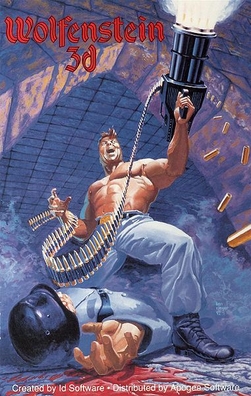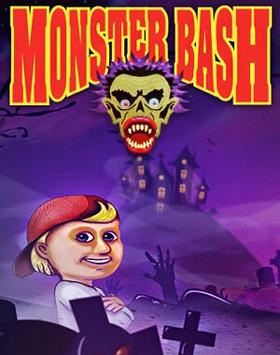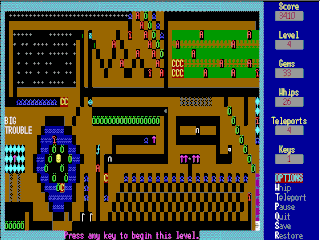
Rise of the Triad: Dark War is a first-person shooter video game, developed and published by Apogee Software in 1995. The player can choose one of five different characters to play as, each bearing unique attributes such as height, speed, and endurance. The game's story follows these five characters who have been sent to investigate a deadly cult, and soon become aware of a deadly plot to destroy a nearby city. Its remake was designed by Interceptor Entertainment and released by Apogee Games in 2013. The shareware version of the game is titled Rise of the Triad: The HUNT Begins.

Wolfenstein 3D is a first-person shooter video game developed by id Software and published by Apogee Software and FormGen. Originally released on May 5, 1992, for DOS, it was inspired by the 1981 Muse Software video game Castle Wolfenstein, and is the third installment in the Wolfenstein series. In Wolfenstein 3D, the player assumes the role of Allied spy William "B.J." Blazkowicz during World War II as he escapes from the Nazi German prison Castle Wolfenstein and carries out a series of crucial missions against the Nazis. The player traverses each of the game's levels to find an elevator to the next level or kill a final boss, fighting Nazi soldiers, dogs, and other enemies with a knife and a variety of guns.
Commander Keen is a series of side-scrolling platform video games developed primarily by id Software. The series consists of six main episodes, a "lost" episode, and a final game; all but the final game were originally released for MS-DOS in 1990 and 1991, while the 2001 Commander Keen was released for the Game Boy Color. The series follows the eponymous Commander Keen, the secret identity of the eight-year-old genius Billy Blaze, as he defends the Earth and the galaxy from alien threats with his homemade spaceship, rayguns, and pogo stick. The first three episodes were developed by Ideas from the Deep, the precursor to id, and published by Apogee Software as the shareware title Commander Keen in Invasion of the Vorticons; the "lost" episode 3.5 Commander Keen in Keen Dreams was developed by id and published as a retail title by Softdisk; episodes four and five were released by Apogee as the shareware Commander Keen in Goodbye, Galaxy; and the simultaneously developed episode six was published in retail by FormGen as Commander Keen in Aliens Ate My Babysitter. Ten years later, a homage and sequel to the series was developed by David A. Palmer Productions and published by Activision as Commander Keen. Another game was announced in 2019 as under development by ZeniMax Online Studios, but was not released.

Duke Nukem Forever is a 2011 first-person shooter game developed by Gearbox Software and published by 2K for Windows, PlayStation 3, and Xbox 360. It is the fourth main installment in the Duke Nukem series and the sequel to Duke Nukem 3D (1996). Players control Duke Nukem as he comes out of retirement to battle an alien invasion. Like its predecessor, Duke Nukem Forever features pop culture references, toilet humor, and adult content.

3D Realms Entertainment ApS is a video game publisher based in Aalborg, Denmark. Scott Miller founded the company in his parents' home in Garland, Texas, in 1987 as Apogee Software Productions to release his game Kingdom of Kroz. In the late 1980s and early 1990s, the company popularized a distribution model where each game consists of three episodes, with the first given away free as shareware and the other two available for purchase. Duke Nukem was a major franchise created by Apogee to use this model, and Apogee published Commander Keen and Wolfenstein 3D the same way.

Crystal Caves is a side-scrolling platform game developed and published by Apogee Software for IBM PC compatibles. The game is divided into three episodes with the first distributed as shareware and the other two available for purchase. Designer Frank Maddin said the method "worked pretty well for the time." Crystal Caves was inspired by the 1982 Atari 8-bit family game Miner 2049er.

Ken's Labyrinth is a first-person shooter for MS-DOS published in 1993 by Epic MegaGames. It was programmed by Ken Silverman, who later designed the Build engine used for rendering in 3D Realms's Duke Nukem 3D (1996). Ken's Labyrinth consists of three episodes, the first of which was released as shareware. An earlier version was self-published by Silverman.

Monster Bash is a side-scrolling platform game developed and published by Apogee Software on 9 April 1993 for DOS. The game features 16-color EGA graphics and IMF AdLib compatible music. It was developed by Frank Maddin and Gerald Lindsly.

Kroz is a series of Roguelike video games created by Scott Miller for IBM PC compatibles. The first episode in the series, Kingdom of Kroz, was released in 1987 as Apogee Software's first game. It was also published on Big Blue Disk #20. Kroz introduced the scheme of the first episode being free and charging money for additional episodes; a technique which defined the business model for Apogee and was adopted by other MS-DOS shareware publishers.
George Broussard is an American video game producer and designer. He is one of the creators of the Duke Nukem series, along with Todd Replogle, Allen Blum, and Scott Miller.

Bio Menace is a 1993 game developed and published by Apogee Software for MS-DOS. A 2D multidirectional scrolling platform game, it was built on a licensed version of id Software's Commander Keen game engine. Apart from the engine and music, all in-game content was created by the game's designer, Jim Norwood. In 2014, the game was re-released on Steam, and in 2015 on GOG.com with support for Microsoft Windows, macOS, and Linux.

Alien Carnage, originally released as Halloween Harry, is a side-scrolling platform game developed by Interactive Binary Illusions and SubZero Software, and distributed by Apogee Software. The game features 256-colour VGA graphics and background music in MOD format. Alien Carnage is composed of four episodes. The first episode was released as shareware, and the rest were distributed commercially. In May 2007, John Passfield and 3D Realms released Alien Carnage as freeware. In 2014, the game was re-released with Windows support.

Pharaoh's Tomb is an MS-DOS platform game created by George Broussard and published by Apogee Software.

Arctic Adventure is a platform game written for DOS, published by Apogee Software. It is the sequel to Pharaoh's Tomb. The protagonist, Nevada Smith, is an archaeologist searching for a Viking treasure in the Arctic. It was re-released on Steam in 2015 with support for Windows and macOS.

Dark Ages is a platform game written for MS-DOS, published by Apogee Software. It was the first shareware game to feature music for the AdLib sound card.

Commander Keen in Keen Dreams is a side-scrolling platform video game developed by id Software and published by Softdisk in 1991 for DOS. It is the fourth episode of the Commander Keen series. The game follows the titular Commander Keen, an eight-year-old child genius, in an adventure in his dreams as he journeys through a vegetable kingdom to defeat the evil potato king Boobus Tuber and free enslaved children from the Dream machine. The game features Keen running and jumping through various levels while opposed by various vegetable enemies; unlike the prior three episodes, Keen does not use a pogo stick to jump higher, and throws flower power pellets to temporarily turn enemies into flowers rather than shooting a raygun to kill them.
The video game Duke Nukem Forever spent more than 14 years in development, from 1996 to 2011. It is a first-person shooter for Windows, PlayStation 3 and Xbox 360, developed by 3D Realms, Triptych Games, Gearbox Software and Piranha Games. It is the sequel to the 1996 game Duke Nukem 3D, as part of the long-running Duke Nukem video game series. Intended to be groundbreaking, it became an infamous example of vaporware due to its severely protracted development schedule. Director George Broussard, one of the creators of the original Duke Nukem game, announced the development in 1997, and promotional information for the game was released from 1997 until its release in 2011.

Commander Keen in Invasion of the Vorticons is a three-part episodic side-scrolling platform video game developed by Ideas from the Deep and published by Apogee Software in 1990 for MS-DOS. It is the first set of episodes of the Commander Keen series. The game follows the titular Commander Keen, an eight-year-old child genius, as he retrieves the stolen parts of his spaceship from the cities of Mars, prevents a recently arrived alien mothership from destroying landmarks on Earth, and hunts down the leader of the aliens, the Grand Intellect, on the alien home planet. The three episodes feature Keen running, jumping, and shooting through various levels while opposed by aliens, robots, and other hazards.















